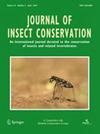变暖实验测试了一种濒危蝴蝶在整个生命历史阶段的温度敏感性
IF 1.9
3区 农林科学
Q2 ENTOMOLOGY
引用次数: 0
摘要
卡纳蓝蝴蝶(Lycaeides melissa samuelis)(以下简称卡纳蓝)是一种联邦濒危物种,分布在美国中西部和东部的分离地点。作为寄主植物专家和变温动物,卡纳蓝很可能容易受到气候变化的影响。我们进行了增温实验,探讨了卡纳蓝不同生活史阶段和性状的温度敏感性。在两年的时间里,我们将所有卡内尔蓝的生命阶段暴露在比1952-1999年平均温度升高+ 2、+ 4和+ 6°C的环境中。我们分析了这些处理对生活史参数的影响,这些参数可能与适应度和种群大小有关,包括发育时间、voltinism、日数积累、体重和形态。暖化处理导致了更早的出现和加速的发展,导致了更多的世代。变暖还增加了成虫前发育(即卵孵化至羽化)期间积累的度日数。结果表明,卡内尔蓝在更短的时间内形成,部分原因是随着温度的升高,质量减少。随着处理温度的升高,成虫体质量、体长和面积减小,毒力增加。成虫质量低、体型小的雌虫产卵量少。这些结果表明,在加速发育和缩小体型之间存在一种权衡关系,成年体重和腹部面积的减少与繁殖力的降低有关。发育时间和voltinism的变化会影响Karner blue与其专性寄主野生羽扇豆(Lupinus perennis)的物候匹配,导致种群减少。例如,昆虫和寄主植物之间较差的物候匹配可能发生在多代之间,从而对越冬种群规模产生负面影响。随着气温的升高,体型较小的雌性会产生更少的卵子,这也会导致后代的种群数量下降。本文章由计算机程序翻译,如有差异,请以英文原文为准。
Warming experiments test the temperature sensitivity of an endangered butterfly across life history stages
Abstract The Karner blue butterfly (Lycaeides melissa samuelis) (hereafter Karner blue) is a federally listed endangered species occurring in disjunct locations within the Midwest and Eastern United States. As a hostplant specialist and an ectotherm, the Karner blue is likely to be susceptible to effects of climate change. We undertook warming experiments to explore the temperature sensitivity of various Karner blue life history stages and traits. Over a two-year period, we exposed all Karner blue life stages to temperature increases of + 2, + 4, and + 6 °C above 1952–1999 mean temperatures. We analyzed the effect of these treatments on life history parameters likely related to fitness and population size, including development time, voltinism, degree-day accumulation, body weight, and morphology. Warming treatments resulted in earlier emergence and accelerated development, leading to additional generations. Warming also increased the number of degree-days accumulated during pre-adult development (i.e., egg hatch to eclosion). Results suggest that Karner blues developed in fewer days, in part, by putting on less mass as temperatures increased. As treatment temperature increased, adult body mass, length, and area decreased and voltinism increased. Females with lower adult mass and smaller body size produced fewer eggs. These results suggest a trade-off between accelerated development and decreased body size with decrease in adult mass and abdominal area being associated with reduced fecundity. Implications for insect conservation Changes in development timing and in voltinism can negatively affect phenological matching between the Karner blue and its obligate host plant, Wild lupine (Lupinus perennis), resulting in population decrease. Poorer phenological matching between insect and hostplant can occur across multiple generations, for example, negatively affecting overwintering population size. With increasing temperatures, smaller females will produce fewer eggs, which can also lead to poorer population outcomes across generations.
求助全文
通过发布文献求助,成功后即可免费获取论文全文。
去求助
来源期刊
CiteScore
3.60
自引率
10.50%
发文量
76
审稿时长
6 months
期刊介绍:
The Journal of Insect Conservation is an international journal devoted to the publication of articles concerned with the conservation of insects and related invertebrates. The Journal of Insect Conservation publishes papers on all aspects of conservation and biodiversity related to the insects and closely related groups such as Arachnids and Myriapods, including ecological work which has conservation implications. Research papers may address the subject at the community, population or species level, may cover aspects of behaviour, taxonomy or genetics, be theoretical or practical, and be local or global in nature. Review articles are welcome as well as points of view which are likely to stimulate debate. From time to time the journal will publish Special Issues on specific subject areas which are the focus of current research. Proposals for such issues are welcome.

 求助内容:
求助内容: 应助结果提醒方式:
应助结果提醒方式:


